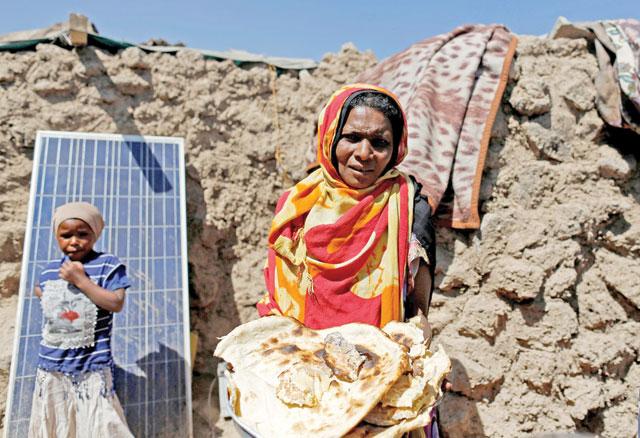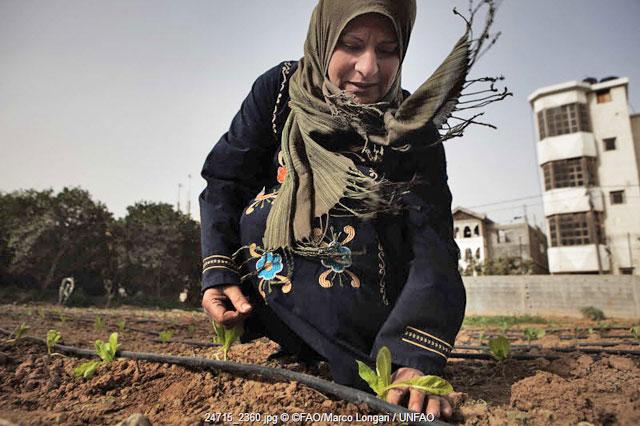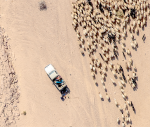You are here
‘Food is a weapon’: fight over Yemen granary tests truce
By AFP - Jan 28,2019 - Last updated at Jan 28,2019

A woman holds bread outside her hut, at a makeshift camp for internally displaced people near Sanaa, Yemen, on Monday (Reuters photo)
HODEIDA, Yemen — Gunshots reverberate through a battle-scarred granary in the port city of Hodeida, where a mountain of grain meant for starving Yemenis remains inaccessible as a hard-won ceasefire comes under strain.
The Red Sea Mills, one of the last positions seized by Saudi and Emirati-backed forces before last month's UN-brokered truce, holds wheat that could feed nearly 4 million people for a month, in a country on the brink of famine.
But the facility, a shrapnel-pocked symbol of how controlling food is a weapon in Yemen's war, has remained off-limits to aid organisations since September, as skirmishes shake the fragile ceasefire agreed with Houthi rebels during talks in Sweden.
The site, on Hodeida's eastern edges, was rigged heavily with mines when it slipped from Houthi control in November.
Last week, during a military embed organised by the Saudi-led coalition, AFP saw government loyalists, including Sudanese soldiers, scouring the vast complex with metal detectors, amid fears rebels were sneaking in to plant new booby traps.
Sudan is a member of the Saudi-led coalition.
A column of smoke snaked into the sky from Houthi positions less than 1.6km away, with loyalists saying the rebels were burning tyres in a provocative move.
Then, a volley of close-range gunshots crackled through the complex. It was not possible to tell who was firing.
‘‘We are committed to the truce... but the enemy has not committed to anything, as you can see and hear,’’ said Yemeni commander, Mohammed Salman.
Just after the tour, the UN on Friday reported apparent mortar shelling at the mill had started a fire that left two food silos damaged.
‘‘The loss of this wheat comes at a terrible time,’’ said the UN's humanitarian coordinator, Lise Grande.
‘‘More than 20 million Yemenis, nearly 70 per cent of the entire population, are hungry.’’
'Red line'
In Hodeida, the entry point for more than two-thirds of Yemen's food imports and international aid, the choices are stark — either an imperfect truce with violations on both sides, or all-out fighting that could unleash famine.
The ceasefire came after Western nations pressed Riyadh to end its four-year military campaign in Yemen, following the murder of Saudi critic and journalist Jamal Khashoggi.
But with recurring breaches, observers warn its collapse could be just a matter of time.
‘‘If it is allowed to break down, there will be no opportunity for a similar deal for a long time,’’ the International Crisis Group said.
Inside Hodeida, a city rippling with tension as the war-wounded continue to trickle into hospitals, a common refrain among civilians and military officials is ‘‘mafi hudna’’ — Arabic for ‘‘no truce’’.
Col. Saeed Salmeen, an Emirati commander on Yemen's west coast, told AFP his men were committed to the ceasefire but were ‘‘always ready’’ for battle.
He warned Yemen's west coast road — a key supply route linking the south to Hodeida — was a ‘‘red line’’.
UN chief Antonio Guterres said on January 7 that neither side had tried to gain new territory since the ceasefire.
But an agreed redeployment of rival forces from the city, a key confidence-building measure, has not happened.
The UN envoy for Yemen, Martin Griffiths, said on Monday that the expected timeline for a truce in Hodeida and a prisoner swap between the warring parties had been pushed back.
‘‘We are dealing with a complex situation on the ground,’’ he told Saudi-owned newspaper Asharq Al Awsat.
‘Food is a weapon’
‘‘How long can the international community accept this Houthi game — ceasefire, regroup, ceasefire, regroup?’’ a member of the coalition told AFP, requesting anonymity.
"Only when you catch them by the neck will they come to the negotiating table."
The sentiment was echoed by other pro-government troops, who insisted to AFP that military action was the only solution.
The truce has given the World Food Programme (WFP) ‘‘some breathing room’’ to reach districts in southern Hodeida, previously inaccessible due to fighting, its country director Stephen Anderson told AFP.
However, 51,000 metric tonnes of wheat — one quarter of the WFP's flour-milling capacity in Yemen — remains locked away in the Red Sea Mills.
The WFP has been trying to get access "to see for ourselves the scale of the damage" after the fire, a spokesman said, adding one of the damaged silos held about 4,500 tonnes of WFP wheat.
For starving Yemenis on both sides of the conflict the lack of access is collective punishment.
Salman, the Yemeni commander, alleged the Houthis hoarded grain, creating artificial shortages and exacerbating famine-like conditions.
When the Houthis controlled the mill, they accused the coalition of destroying food with indiscriminate air strikes.
The mills are ‘‘being used in the most Machiavellian ways by all warring parties to achieve political goals’’, said Wesam Qaid, executive director of Yemeni development organisation SMEPS.
‘‘Whoever controls such facilities will have greater say on who gets fed. Food is a weapon.’’
Related Articles
AMMAN — If you walked onto the grounds of the World Food Programme’s (WFP) country office in Amman last week, you would have been met with a
The number of undernourished in the Near East and North Africa (NENA) has more than doubled since 1990 standing now at about 33 million peoples, according to the recently released UN Hunger Report.
NEW DELHI/DUBAI — India said on Sunday it will send a government minister to Saudi Arabia to try to bring back more than 10,000 Indian worke















